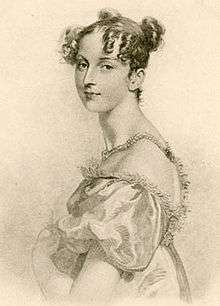Lieven

The Lievens (Latvian Līveni; German Liewen) are one of the oldest aristocratic families of Baltic Germans. Caupo's grandson, Nicholas, was the first to spell his name Lieven.
History
They claim descent from Caupo of Turaida (Latvian, Kaupo), the Livonian quasi rex who converted to Christianity in 1186, when Bishop Meinhard attempted to Christianize the region. Henrici Chronicon Lyvoniae tells that Caupo in winter 1203-1204 went to Rome with Theodoric, a Cistercian Monk (who was to become the founder of the Livonian Brothers of the Sword, then the first bishop of Estonia).[1] They were received by the Pope Innocent III who backed up their plans to Christianize Livonia.
According to feudal records, the Lieven ancestor Gerardus Līvo (1269) and his son Johannes (1296) entered service as vassals to the archbishop of Rīga. One of Caupo's daughters married an ancestor of the barons, then counts of Ungern-Sternberg.
Family members


Reinhold Liewen, the Swedish governor of Oesel (Saaremaa), in 1653 was made a baron together with his brother, whose son Lieutenant-General Baron Hans Heinrich von Liewen accompanied Charles XII in all his campaigns and expeditions. Among Reinhold's descendants, one branch settled in Courland and was recognized in 1801 as in the Holy Roman Empire. Johann-Christoph von Lieven was the first member of the family to gain distinction in the Russian service: he served as Governor of Arkhangelsk under Catherine the Great and as General of Infantry under Emperor Paul.
Baron Otto Heinrich von Lieven (1726–1781) married in 1766 Baroness Charlotte von Gaugreben (1743–1828),[2] who was entrusted by Emperor Paul with the task of educating his daughters and younger sons - Nicholas and Mikhail Pavlovich. In recognition of her services Paul made her a countess in 1799. When her pupil Nicholas became the Emperor of Russia in 1826, the 84-year-old governess was made a Princess with the title of Her Serene Highness. The title was hereditary and passed to her descendants, of which the following were notable.
- Her son, Prince Christoph Heinrich von Lieven (1774–1838), accompanied Alexander I of Russia during the Battle of Austerlitz and at the signing of the Peace of Tilsit. In 1809 he was sent to represent Russia at the Prussian court and, at the crisis of the Napoleonic Wars in 1812, was transferred as the Minister Plenipotentiary to the court of St. James's, a post which he kept for 22 years. Somewhat overshadowed by his more illustrious wife, Dorothea von Lieven, Prince Lieven took part in the Congress of Vienna and died in Rome when he accompanied the future Alexander II of Russia on his Grand Tour.[3]
- His elder brother, Prince Carl Christoph von Lieven (1767–1844), started his career as an aide-de-camp to Prince Potemkin, administered the garrison of Arkhangelsk under Paul and ended his career as Imperial Minister of Education (1828–33).
- Prince Alexander Karlovich Lieven (1801–1880), son of the preceding, Major-General, served as Governor of Taganrog in 1844-1853, and senator 1853-1880.
- Prince Andrey Alexandrovich Lieven (1839–1913), his son, was the Senator and Minister of State Properties in 1877-81.
- Jelena Lieven (1842–1917), Imperial Russian pedagogue, sister of the above
- Prince Alexandr Alexandrovich Lieven (1860-...), was an admiral of the Imperial Russian Navy: in 1878 entered in service; in 1911 was appointed chief of the naval general staff.[4]
- Prince Anatoly Pavlovich Lieven (1872–1937) commanded a Russo-German battle group in Latvia; Lieven forbade his men to fight the Estonian Army in Vidzeme, unlike the rest of the Baltische Landeswehr. His Liventsy performed only rear security services for the Landeswehr during the campaign.[5] After the Latvian War of Independence he became a Latvian citizen and a manufacturer of bricks.
- Elena Lieven (born 1947), a developmental psychologist at the Max Planck Institute for Evolutionary Anthropology in Leipzig and the University of Manchester.
- Dominic Lieven (born 1952), senior research fellow, Trinity College, Cambridge and Fellow of the British Academy.
- Anatol Lieven (born 1960), a British author, journalist, and policy analyst.
- Albert Lieven (1906–1971), German actor
- Heinz Lieven (born 1928), German actor
- Tobias Gerald Albert Lieven Flood (Toby Flood)[6] (born 1985), grandson of Albert Lieven, England test rugby footballer.
In popular culture
Thomas Lieven is the name of the fictional protagonist of the tongue-in-cheek spy novel "It Can't Always Be Caviar" by Austrian writer Johannes Mario Simmel.
References
- ↑ Marek Tamm; Linda Kaljundi; Carsten Selch Jensen (1 November 2011). Crusading and Chronicle Writing on the Medieval Baltic Frontier: A Companion to the Chronicle of Henry of Livonia. Ashgate Publishing, Ltd. pp. 215–. ISBN 978-0-7546-6627-1. Retrieved 14 August 2012.
- ↑ Carl Arvid von Klingspor (1882). Baltisches Wappenbuch. Elibron.com. pp. 1–. ISBN 978-0-543-98710-5. Retrieved 14 August 2012.
- ↑ Judith Lissauer Cromwell (2007). Dorothea Lieven: A Russian Princess in London And Paris, 1785-1857. McFarland. pp. 7–. ISBN 978-0-7864-2651-5. Retrieved 14 August 2012.
- ↑ Aleksandr Vasiliyevich Kolchak; Konstantīn Andreevīch Papov; Anton Zakharovich Ovchinnikov (1935). The Testimony of Kolchak and Other Siberian Materials. Stanford University Press. pp. 220–. ISBN 978-0-8047-2220-9. Retrieved 14 August 2012.
- ↑ Nikolai Reek. Lemsalu — Roopa — Võnnu — Ronneburgi lahing 19. — 23. VI. 1919. a. (Lemsalu — Roopa — Võnnu — Ronneburg battle 19. — 23. VI. 1919 (in Estonian). Estonian National Defence College museum. Archived from the original on 22 August 2010.
- ↑ "Toby Flood". Scrum.com. Retrieved 5 April 2009.
External links
| Wikimedia Commons has media related to Lieven. |
- Lieven Family in Online Gotha
- (in Latvian) Lieven family, Latvian Encyclopedia (Latvian)
- (in German) Genealogisches Handbuch der Oeselschen Ritterschaft 1935 - Genealogy handbook of Baltic nobility
- (in Swedish) von Lieven in Svenskt biografiskt handlexikon
- (in Swedish) von Lieven in Nordisk familjebok
- Lievens